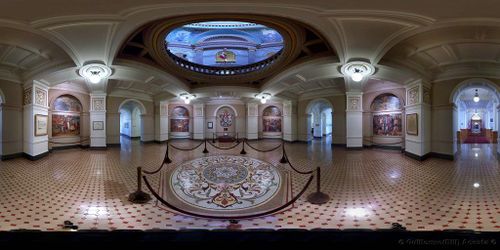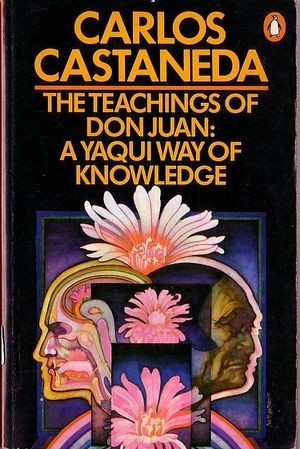GRSJ224/Cultural Appropriation of Indigenous Cultures
Cultural appropriation is an unauthorized use by members of one culture of the cultural expressions and resources, such as symbols, artifacts, genres, rituals, or technologies, of another culture.[1][2] The term can also be interpreted in terms of proprietary claims over knowledge.[3] Cultural appropriation is an active process associated with ‘‘taking"; simple exposure to another culture (eg. watching a movie, listening to the music) would not be an appropriation.[4]
Overview
The colonization of Indigenous peoples around the world "involved the appropriation of their land, art objects and ceremonial artifacts, and extinction or near extinction of their languages, practices,the flora and fauna of their habitats, and, not least, of their spiritual beliefs and practices by the missionizing practices of the colonizing culture."[5] Cultural appropriation violates property rights and is an attack on cultural identity; it may leave members of the affected culture vulnerable to poverty, lack of opportunity, discrimination.[6]
The boundaries of cultural appropriation may be unclear at times. In the late 19th and early 20th century, Indigenous people would sell personal and community objects, including ceremonial or sacred objects, in order to survive. In the early days of colonialism, many Indigenous communities suffered from colonial powers, which depleted their resources and destabilized societal structures. Some researchers argue that the trade of artifacts would never take place were it not for the damage done by colonialism. Although exchange took place, it was unequal and is still considered cultural appropriation. [7][8]
Ethical view on cultural appropriation
An assumption that there are shared moral values among cultures underlies the moral discourse around cultural appropriation. Demeaning or highly offensive actions are considered morally wrong. The concept of profound offence was introduced by Joel Feinberg, an American political and legal philosopher, and can be applied to the moral reasoning. Profound offence is distinct from ordinary offence and affects a person’s core values and a source of self.[9] The British Columbia Legislature’s murals attracted much controversy. They are called Labour, Justice, Enterprise, and Courage, and depict an early colonial history of the province. For instance, Labour depicts bare-breasted Indian women working under a command of white men during the construction of Fort Victoria. Indigenous leaders in British Columbia argued that the murals were “highly offensive, demanding and degrading to First Nations people.” [10] The murals were removed following a vote of B.C. Legislature in 2007.[11] Acts of cultural appropriation can be assessed through the concept of respect. To respect someone is to have due regard for their feelings, wishes, or rights.[12] So showing respect to a culture or its members would be an effort to avoid profound offence.[13]
Generally, the concept of cultural appropriation has received little attention from philosophers. James O. Young, a modern Canafian philosopher, wrote extensively on the subject. He acknowledged the offensive side of cultural appropriation in arts but was “deeply skeptical about the claim that artists will do much harm to the cultures from which they borrow.”[14] Another view on cultural appropriation would be through the lens of cultural relativism. Cultural relativism is an idea that a person's beliefs, actions, or values should be understood based on that person culture's point of view.[15] Following this principle, what is considered an act of appropriation in one culture may not be one in another.
Examples of cultural appropriation
Archaeological finds
Inukshuk (inuksuit, for plural) is a stone figure constructed by the Inuit and can be found throughout the Arctic region. Inuksuit were used as a navigational aid and messaging centers. Moreover, some old inuksuit have a spiritual connotation and are mentioned in Aya-yait, the traveling songs passed from one generation to another. [16] The image of inukshuk has become a frequent object of appropriation. It has been used "in over 100 advertisements to sell everything from real estate to erectile dysfunction drugs; a stylized version has recently been chosen by the International Olympic Committee as the symbol for the 2010 Olympics in Vancouver, British Columbia."[17]
Appropriation of human remains
The appropriation of human remains was justified for scientific or academic purposes. Some researchers argue that this appropriation did not benefit Indigenous people or science. A significant number of human remains of Indigenous people is a part of various collections around the world. The Canadian Museum of Civilization has around three thousand of partial or complete skeletons. In Canada, the First Nations burial sites and cemeteries are protected by certain provincial legislation including the Saskatchewan Heritage Property Act and the Prince Edward Island Ancient Burial Grounds Act (1974). However, heritage acts of other provinces are vague on the protection of Aboriginal burial grounds and skeletal remains. [18]
Appropriation of religion
The appropriation of religion distorts the religion and spirituality of Indigenous culture by the dominant culture. It leads to a misrepresentation of people's character and threatens their cultural identity.[19] Carlos Castaneda’s The Teachings of Don Juan: A Yaqui Way of Knowledge (1968) has sold four million copies; in the book Castaneda claims to reveal the spiritual secrets of the indigenous belief system of Don Juan Matus, a Yaqui shaman from Mexico. The book was highly appraised in both popular and academic press and was considered a legitimate anthropological work despite numerous inconsistencies. For example, Castaneda misused Yaqui terminology; some Yaqui practices he described echoed Tantric Buddhism and Hindu chakras. Critics argued that these practices were "rewritten in a manner carefully calculated to appeal to tastes and desires of the mostly white counterculturalists comprising the lion's share of Castaneda's mass market". In spite of the controversy, the book is still classified as a reference to Indians of North America, Yaqui tribe, in the Library of Congress. [20]
Response to cultural appropriation
There are two types of responses to appropriation. A restrictive response would be to use legal, social, or political mechanisms to control or restrict access to knowledge and objects. These mechanism would include copyrights, trademarks, and patents. An example of a restrictive response: "In British Columbia, the Nanaimo First Nation successfully registered with the Canadian Intellectual Property Office ten ancientpetroglyphs as ‘official marks’ to prevent them from being copied and reproduced by anyone for any purpose, arguing the images are sacred and copies for any reason are sacrilegious."[21]
An inclusive response would be to engage into consultation with descendant communities to ensure that their interests are respected and appropriation does not take place. An example of an inclusive response: "Based at the University of British Columbia, the Reciprocal Research Network is an initiative linking UBC’s Museum of Anthropology with Aboriginal communities and both national and international museums. Developed in conjunction with the Musqueam Indian Band, Sto:lo Nation and U’mista Cultural Society, it is designed to support collaborative research through a virtual museum-type platform".[22][23]
References
<references>
- ↑ Riley, A. R., Carpenter, K. A., Owning Red: A Theory of Indian (Cultural) Appropriation: Texas Law Review ; Austin 94.5 (2016): 859-931.
- ↑ Rogers, R. A.,From Cultural Exchange to Transculturation: A Review and Reconceptualization of Cultural Appropriation: Communication Theory 16 (2006) 474–503 ª 2006 International Communication Association
- ↑ Coleman, E. B., (2005) Aboriginal art, identity, and appropriation. Aldershot, Hants, England ; Burlington, VT : Ashgate
- ↑ Rogers, R. A.,From Cultural Exchange to Transculturation: A Review and Reconceptualization of Cultural Appropriation: Communication Theory 16 (2006) 474–503 ª 2006 International Communication Association
- ↑ Brunk C.G, Young J.O. ‘The Skin Off Our Backs’ Appropriation of Religion:The Ethics of Cultural Appropriation Edited by Edited by James O. Young and Conrad G. Brunk © 2009 Blackwell Publishing Ltd. ISBN: 978-1-405-16159-6
- ↑ Introduction: The Ethics of Cultural Appropriation Edited by Edited by James O. Young and Conrad G. Brunk © 2009 Blackwell Publishing Ltd. ISBN: 978-1-405-16159-6
- ↑ Berman, T., Cultural Appropriation: A Companion to the Anthropology of American Indians Edited by Thomas Biolsi Copyright © 2004 by Blackwell Publishing Ltd
- ↑ Walsh A.N, Lopes D.M, Objects of Appropriation: The Ethics of Cultural Appropriation Edited by Edited by James O. Young and Conrad G. Brunk © 2009 Blackwell Publishing Ltd. ISBN: 978-1-405-16159-6
- ↑ Introduction: The Ethics of Cultural Appropriation Edited by Edited by James O. Young and Conrad G. Brunk © 2009 Blackwell Publishing Ltd. ISBN: 978-1-405-16159-6
- ↑ Walsh A.N, Lopes D.M, Objects of Appropriation: The Ethics of Cultural Appropriation Edited by Edited by James O. Young and Conrad G. Brunk © 2009 Blackwell Publishing Ltd. ISBN: 978-1-405-16159-6
- ↑ https://www.thestar.com/news/2007/06/25/degrading_bc_murals_removed.html
- ↑ https://en.oxforddictionaries.com/definition/respect
- ↑ Introduction: The Ethics of Cultural Appropriation Edited by Edited by James O. Young and Conrad G. Brunk © 2009 Blackwell Publishing Ltd. ISBN: 978-1-405-16159-6
- ↑ Matthes, E. H., Cultural Appropriation Without Cultural Essentialism?: Social Theory and Practice, Vol. 42, No. 2 (April 2016): 343-366 DOI: 10.5840/soctheorpract201642219
- ↑ https://en.wikipedia.org/wiki/Cultural_relativism
- ↑ http://www.thecanadianencyclopedia.ca/en/article/inuksuk-inukshuk/
- ↑ George P.N.,Wylie, A, Archaeological Finds: Legacies of Appropriation, Modes of Response: The Ethics of Cultural Appropriation Edited by Edited by James O. Young and Conrad G. Brunk © 2009 Blackwell Publishing Ltd. ISBN: 978-1-405-16159-6
- ↑ James [Sa′ke′j] Youngblood Henderson, The Appropriation of Human Remains: A First Nations Legal and Ethical Perspective: The Ethics of Cultural Appropriation Edited by Edited by James O. Young and Conrad G. Brunk © 2009 Blackwell Publishing Ltd. ISBN: 978-1-405-16159-6
- ↑ Brunk C.G, Young J.O. ‘The Skin Off Our Backs’ Appropriation of Religion:The Ethics of Cultural Appropriation Edited by Edited by James O. Young and Conrad G. Brunk © 2009 Blackwell Publishing Ltd. ISBN: 978-1-405-16159-6
- ↑ Churchill, W. (1998). Fantasies of the Master Race: Literature, Cinema and the Colonization of American Indians. San Francisco, City Lights Books.
- ↑ Nicholas G.P., Wylie A., Archaeological Finds: Legacies of Appropriation, Modes of Response: The Ethics of Cultural Appropriation Edited by Edited by James O. Young and Conrad G. Brunk © 2009 Blackwell Publishing Ltd. ISBN: 978-1-405-16159-6
- ↑ Nicholas G.P., Wylie A., Archaeological Finds: Legacies of Appropriation, Modes of Response: The Ethics of Cultural Appropriation Edited by Edited by James O. Young and Conrad G. Brunk © 2009 Blackwell Publishing Ltd. ISBN: 978-1-405-16159-6
- ↑ http://www.moa.ubc.ca/RRN/ about_overview.html


